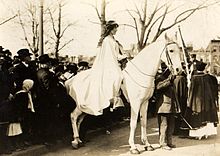Wikipedia:Image citation/Sample
Inez Milholland | |
|---|---|
 | |
| Born | August 6, 1886 Brooklyn, New York |
| Died | November 25, 1916 (aged 30) Good Samaritan Hospital Los Angeles |
| Education | Vassar College |
| Spouse | Eugene Jan Boissevain (m. 1913) |
Inez Milholland Boissevain (August 6, 1886 – November 25, 1916) was a suffragist, labor lawyer, World War I correspondent, and public speaker who greatly influenced the women's movement in America.
Biography
[edit]Born and raised in Brooklyn, New York, she grew up in a wealthy family. She was the eldest daughter of John Elmer and Jean (Torrey) Milholland. She had one sister and one brother. Her father was a New York Tribune reporter and editorial writer who eventually headed a pneumatic tubes business that afforded his family a privileged life in both New York and London. Her father supported many reforms, among them world peace, civil rights, and women suffrage. Her mother exposed her children to cultural and intellectual stimulation.[1]
On July 14, 1913, she was married in London, England to Eugen Jan Boissevain, a Dutch importer. She admitted to proposing to Boissevain first, and she referred to this initiative as being a woman's "new freedom." They never had children.[2][3]
Activism
[edit]
Her causes were far reaching: in addition to prison reform, she sought world peace and worked for equality for African Americans. Milholland was a member of the NAACP, the Women's Trade Union League, the Equality League of Self Supporting Women in New York (Women's Political Union), the National Child Labor Committee, and England's Fabian Society.[2] She was also involved in the National American Woman Suffrage Association, which later branched into the grassroots radical National Woman's Party. She became a leader and a popular speaker on the campaign circuit of the NWP, working closely with Alice Paul and Lucy Burns.

In 1913, at the age of 27, Milholland made her most memorable appearance, as she helped organize the suffrage parade in Washington D.C., scheduled to take place the day before President Woodrow Wilson's inauguration. She led the parade wearing a crown and a long white cape while riding atop a large white horse named "Gray Dawn."[2]
At the beginning of World War 1, Milholland traveled overseas as a war correspondent for a Canadian newspaper to gain access to the front lines. From there she composed pacifist articles, which led to her censure by the Italian government, which ousted her from the country.
She was also a leading figure on Henry Ford's ill-fated Peace Ship expedition of late 1915, steaming across the Atlantic with a team of pacifist campaigners who hoped to give impetus to a negotiated settlement to the First World War. However, she left the ship in Stockholm because the trip was unorganized and dissension had ensued between passengers.[2] Her role has recently been fictionalized by the British novelist Douglas Galbraith in his novel King Henry.
Milholland vehemently protested against America's involvement in World War I. She was a labor lawyer and was involved in the production of the socialist journal, The Masses.
References
[edit]- ^ "Inez Milholland". Vassar College Encyclopedia. 2006. Retrieved July 21, 2012.
- ^ a b c d Marilyn Elizabeth Perry. "Boissevain, Inez Milholland"; American National Biography Online. Feb. 2000.
- ^ "Profiles: Selected Leaders of the National Woman's Party". American Memory. The Library of Congress. Retrieved July 19, 2009.
- ^ Dummy caption reference, for demonstration.
Images
[edit]- ^ "Miss Inez Milholland". Halftone photomechanical print, [ca. 1911]. Library of Congress Prints and Photographs Division, LC-USZ62-110994.
- ^ "[Inez Milholland Boissevain, wearing white cape, seated on white horse at the National American Woman Suffrage Association parade, March 3, 1913, Washington, D.C.]". Photographic print, [19]13 March 3. Library of Congress Prints and Photographs Division, LC-DIG-ppmsc-00031.
- ^ Harris & Ewing, "[Congressional Union of Woman Suffrage]". Glass negatives, [between 1910 and 1920]. Library of Congress Prints and Photographs Division, LC-DIG-hec-13619.
External links
[edit]- Inez Milholland Papers. Schlesinger Library, Radcliffe Institute, Harvard University.
- Sidesaddles and suffragettes – the fight to ride and vote Horsetalk.co.nz
- "Inez Milholland Portrait Restoration Planned" The Adirondack Almanack, April 23,2010
- "Inez Milholland". Suffragist. Find a Grave. April 20, 2004. Retrieved August 18, 2011.
